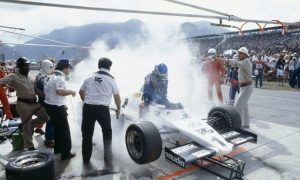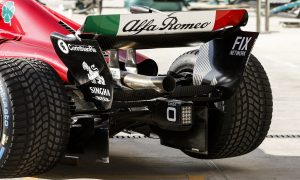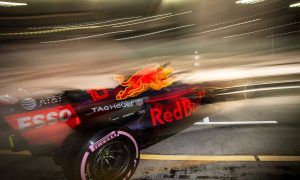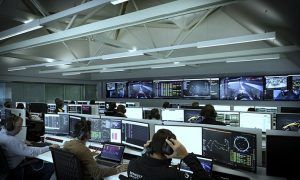CHANGE AND CONTINUITY AT FERRARI
While the picture above was snapped in the desert, it’s not a mirage, but a view of the power unit that propelled Sebastian Vettel’s Ferrari SF70H to the Bahrain Grand Prix win last Sunday.
From the image, one can surmise that Maranello’s 062 engine still has the compressor and turbine at the back of the unit, just like on the Renault engine. This means that, contrary to rumours circulated over the winter, the Scuderia have not adopted Mercedes’ signature split-turbo design (whereas Honda has).
While the shot does not allow a full installation view, it seems that the two-pronged cooling system seen on last year’s Ferrari charger has not been retained. The carbon duct that used to hug the left-hand side of the unit has disappeared, while the oil tank is no longer featuring on the right. However, one shall remain prudent and wait for more photo evidence to confirm the architecture.
On the 2017-spec engine, the water-to-water intercooler sits atop the rear part of the engine. The rectangular-shaped element is hugged by the pipework that channels air from the air intake above the driver’s head to the compressor.
The architecture does bear some resemblance to the concept used in 2014 and 2015, except that the intercooler was lodged much lower, within the ‘Vee’ of the engine, which did not allow for variable inlet trumpets. By comparison, the radiator looks more compact and has been placed higher on this year’s Ferrar power unit.

POWERFUL, ALBEIT FRAGILE?
With each engine having to complete around five grand prix weekends, reliability is increasingly vital – each driver has four power units for 20 races compared to five units for 21 events last year. Ferrari has not been flawless in that area this year so far, with Kimi Raikkonen’s energy store (or battery) and control electronics needing replacement in Melbourne.
Although there was no issue to report in China, the Finn once again suffered technical gremlins at Sakhir with a change of internal combustion engine (ICE), turbocharger and MGU-H. Out of caution, Vettel’s control electronics, turbocharger, and MGU-H were also replaced.
All components will be carefully studied and checked back at Maranello and the Italian team hope it can re-use most of these parts in future free practice sessions. With only three grand prix weekends in the books, it is still too early to say whether Ferrari will go over its four-engine allocation and incur grid penalties as a consequence.

 '
'




